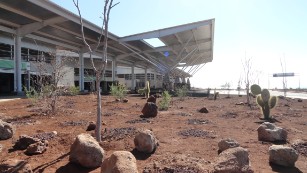This is a pretty remarkable achievement for any airport. Not surprising it happens in a very natural, environmentally dependent island, but it clearly shows what is possible in terms of all airports reducing their carbon footprint.
Please go to our main site and listen to our segment with the sustainability director at Denver's Int Airport. Clearly, they are not yet at 100% renewables, but their dedication to ecological management and investment in reducing energy use and waste is just as impressive.
Travel will be much more enjoyable for all of us as airports, planes, hotels, shuttles and we buy into a cleaner way of enjoying seeing other parts of the world.
This airport runs on wind
(CNN)The Galapagos Islands are among the most environmentally precious -- and sensitive -- regions on earth. Airports, by contrast, tend to leave a pretty disastrous carbon footprint. It should come as no surprise that the Galapagos is also home to what has been hailed as the world's first "green" airport.
Galapagos Ecological Airport (formally Seymour Airport) was built in 2012 to run solely on solar and wind power, and 80% of its infrastructure is made from materials recycled from the old building. It even has mechanical shutters that open and close depending on the building's heat and CO2 levels. Fresh water comes care of the airport's own desalination plant, which converts local seawater.
The U.S. Green Building Council gave the $40 million project a thumbs up last November by awarding it the Leadership in Energy and Environmental Design (LEED) Gold certificate.
According to Ezequiel Barrenechea, CEO of Ecogal Corporation -- the firm in charge of the project -- building an airport to be green is not without its challenges. Since the Galapagos is a UNESCO World Heritage Site, most of the building had to be done on Ecuador's mainland. He says it took a year alone to train his engineers and architects in sustainable construction.
"All these things were difficult, believe me, but it was a pleasure. The final result of this is a project that's unique and an example for all of the world," he says.
A wonder of the world
As a popular tourist destination, the Galapagos Islands attract travelers who are keen to admire the world renown bio-diversity (once a source of inspiration to Charles Darwin, who used it as the basis for his theory of evolution). Barrenechea believes the airport will be another draw for a group of travelers that are already environmentally minded.
"The people that travel to Galapagos are people who are almost fanatical about ecology," he says.
"That kind of tourist is the first to appreciate this project because they travel to Galapagos to feel the ecological side of the world. Part of the requirement of our certification is to teach people about what we've built, how we've built it and why. People will love it."
The airport is now planning to earn certifications for the Reduction of Carbon Footprint and Green Operation and Maintenance.
Eco airports: present and future
Other airports have started to take a more environmental approach to their design. Boston Logan International Airport, for instance, was the first to be certified by the U.S Green Building Council, and in Europe, airports in Switzerland, Spain and the United Kingdom have also been recognized for their green efforts, such as installing wind turbines on site to relying heavily on solar power for energy.
There's more to come in the future too.
Plans are currently underway for the construction of a new "eco-airport" in the Philippines. Based in the Bohol province, the airport will have solar-powered air conditioning and LED lights. It is projected to replace the current Tagbilaran Airport by early 2018. The Mexico City International Airport -- a yet-to-be-built collaboration between Foster + Partners, FR-EE (Fernando Romero Enterprise) and NACO (Netherlands Airport Consultants), is hoping, upon completion, to wrestle the title of the world's most sustainable airport.


No comments:
Post a Comment